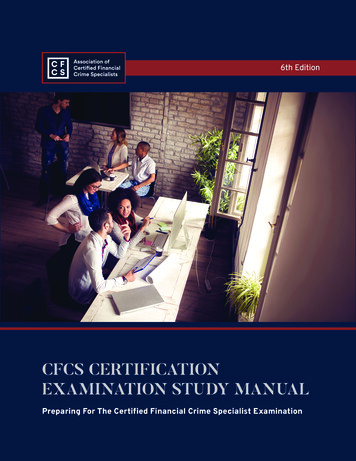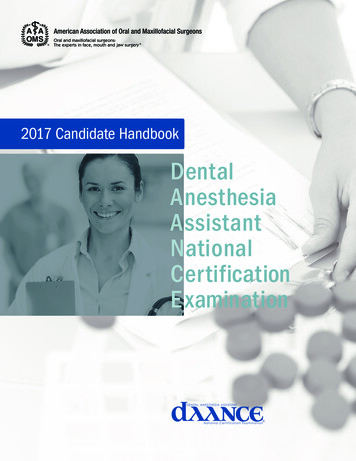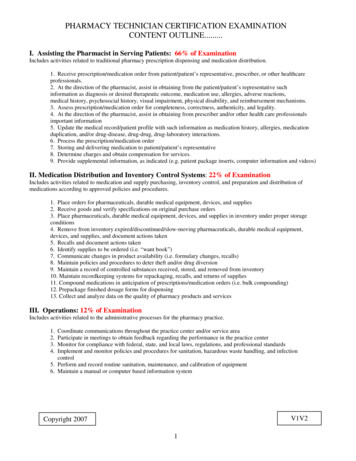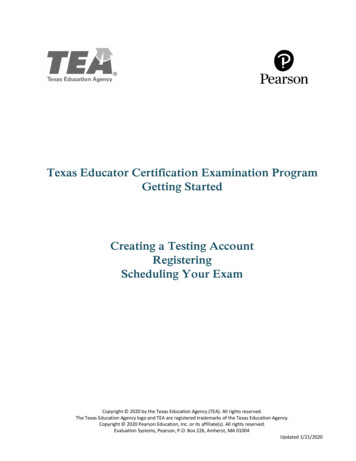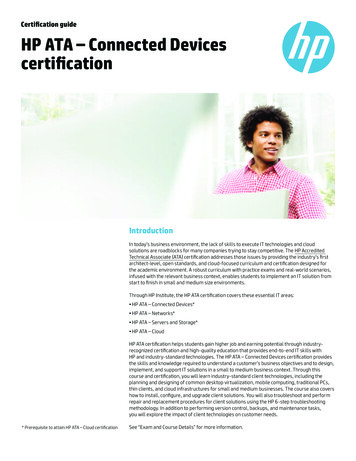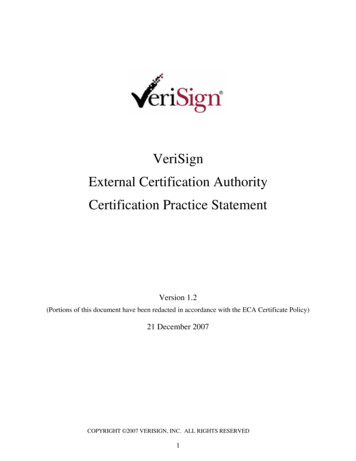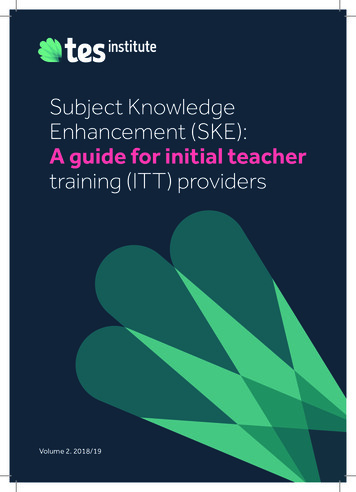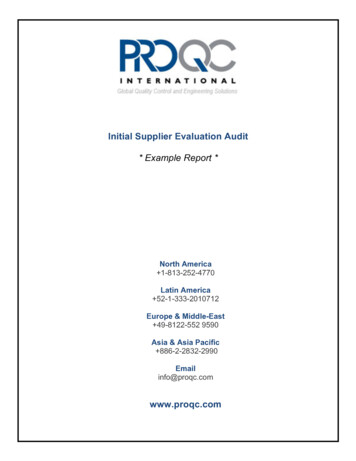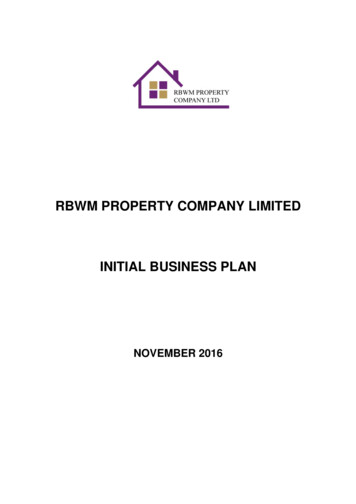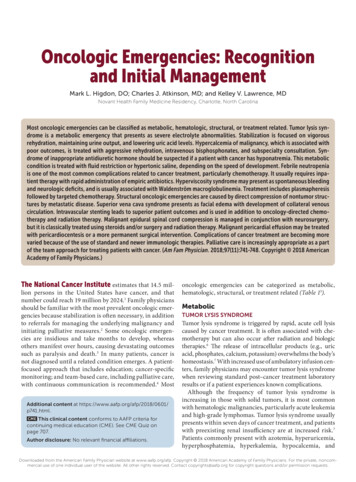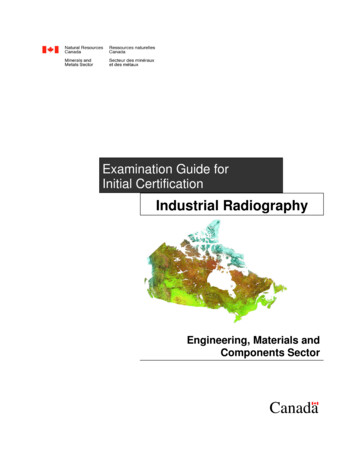
Transcription
Examination Guide forInitial CertificationIndustrial RadiographyEngineering, Materials andComponents Sector
NDT Certifying AgencyCANMET Materials Technology LaboratoryNatural Resources Canada183 Longwood Road SouthHamilton, OntarioCanada L8P 0A5Telephone: 866-858-0473Web Site: -eng.htmCe guide est aussi disponible en français à l'adresse suivante :Organisme de certification en ENDLaboratoire de la technologie des matériaux de CANMETRessources naturelles Canada183 Rue Longwood SudHamilton (Ontario)Canada L8P 0A5Téléphone : 866-858-0473Site Web : -fra.htm
NRCan/MTL/NCBDOC. 4-9-RTemcApproved by: NCB ManagerCLIENT INFORMATIONISSUE: 3DATE: December 1, 2002PAGE: 1 of 51TABLE OF CONTENTSPAGEAIntroduction2BSuggestions for the successful completion of written examinations for certificationin Nondestructive Testing3C.1Level 1 Examination Scheme4C.2References to Prepare for the Level 1 Written Examinations5C.3Sample Questions for the Level 1 Written Examinations6C.4General Information for the Level 1 Practical Examinations12C.5Test Program for the Level 1 Practical Examinations12C.6Hints for Successful Level 1 Practical Examinations13D.1Level 2 Examination Scheme14D.2References to Prepare for the Level 2 Written Examinations15D.3Sample Questions for the Level 2 Written Examinations16D.4General Information for the Level 2 Practical Examinations23D.5Test Program for the Level 2 Practical Examinations23D.6Hints for Successful Level 2 Practical Examinations28E.1Level 3 Examination Scheme29E.2References to Prepare for the Level 3 Written Examinations30E.3Sample Questions for the Level 3 Written Examinations31E.4General Information for the Level 2 Practical Examinations[for Level 3 Candidates Not Previously Certified Level 2]41E.5Test Program for the Level 2 Practical Examinations41E.6Hints for Successful Level 2 Practical Examinations45
NRCan/MTL/NCBDOC. 4-9-RTemcApproved by: NCB ManagerACLIENT INFORMATIONISSUE: 3DATE: December 1, 2002PAGE: 2 of 51INTRODUCTIONNatural Resources Canada (NRCan), through the Materials Technology Laboratory (MTL) of Minerals andMetals Sector (MMS), is the NDT Certifying Agency for the Canadian Nondestructive Testing PersonnelCertification Program. NRCan certifies individuals according to CAN/CGSB 48.9712 standard.In performing this function, NRCan carries out the following tasks:a) examines information provided by the applicant to ensure that the applicant has the basic education,NDT training and experience required by the standard;b) prepares, supervises and evaluates both written and practical examinations;c) maintains a network of test centres across Canada for both written and practical examinations;d) renews certificates of candidates as specified by the standard; and,e) recertifies candidates as specified by the standard.In certifying the candidate, NRCan is only attesting that the candidate has demonstrated sufficientknowledge, skill, training and experience to meet the requirements of the CAN/CGSB 48.9712 standard.NRCan cannot attest to the operators competence in any specific situation at the time of original certificationor at any time thereafter.In undertaking the administration of the program, NRCan attempts to provide the unbiased Canada-wideservices required to implement a national program. An Advisory Committee composed of individualsknowledgeable about NDT in Canada advises NRCan on the operation of this program.
NRCan/MTL/NCBDOC. 4-9-RTemcApproved by: NCB ManagerBCLIENT INFORMATIONISSUE: 3DATE: December 1, 2002PAGE: 3 of 51SUGGESTIONS FOR THE SUCCESSFUL COMPLETION OF WRITTEN EXAMINATIONS FORCERTIFICATION IN NDT1. Do some personal studying prior to attempting the written examinations. In general, training coursesare meant to complement your personal efforts, not to substitute them. Furthermore, training coursestend to cover a lot of material over a short period of time. To assimilate the subject material covered, agreat deal of personal studying is usually necessary.Note: The marks obtained on a training course test should not be used to gauge your eventualperformance on NRCan examinations. Usually, applicants find NRCan examinations more difficult.2. Before starting a test, read all the instructions.3. Before answering a multiple choice question read the stem and all of the options. Remember, only thebest answer is correct.4. If a question is difficult to answer, proceed by elimination. This will often result in having to choosebetween two possible options.5. If you cannot answer a question, do not waste time, proceed to the next question. If you complete thetest before the time limit, return to the unanswered questions.6. To test your skills, we recommend the following sample questions that are available on the market:a) Ginzel Bros. NDT Testmaker Questions Data Baseb) Supplements to Recommended Practice SNT-TC-1A (Question and Answer Books)Reference MaterialThe textbooks identified in this guide as reference study material may be purchased from the followingsources:Canadian Institute for NDE135 Fennell Avenue W. Port. #7Hamilton, OntarioL8N 3T2Telephone: (905) 387-1640Facsimile: (905) 574-6080ASNT1711 Arlingate LaneP.O. Box 28518Columbus, Ohio43228 - 0518U.S.A.Telephone: (614) 274-6003 or 1-800-222-2768Facsimile: (614) 274-6899
NRCan/MTL/NCBDOC. 4-9-RTemcApproved by: NCB ManagerISSUE: 3DATE: December 1, 2002PAGE: 4 of 51CLIENT INFORMATIONC.1 LEVEL 1 EXAMINATION SCHEME TO MEET THE CAN/CGSB - 48.9712 STANDARDLEVEL 1 RT WRITTEN AND PRACTICAL EXAMINATIONS IN THEENGINEERING MATERIALS AND COMPONENTS (EMC) SECTOREXAMINATIONPASSGeneralPaper 70%40 m.c.q. on theoretical principles of RTmethod1 hourEMC Paper(Multi-Sector) 70%40 m.c.q. total:-15 m.c.q. on flaws, their names, locations andappearances, detectable by RT,-25 m.c.q. on RT applications and simpletechniques.1 hourRadiationProtection Paper 70%25 m.c.q. applicable to radiation safety1 hourGeneralPracticalEMC Practical(Multi-Sector) 70% 70%CONTENTDURATIONMake the required settings and operate thetest equipment properly in order to obtainsatisfactory results and correctly interpretresults. Includes producing an exposurechart on semi-log graph paper for a givenexposure energy.Inspect 2 specimens, or parts thereof accordingto written instructions.m.c.q. Y multiple choice questionsCOMMENTSNeed not be repeated forother sectors.Applicable to levels 1, 2 & 3.Need only be done once.Need not be repeated forother sector.All tests done according towritten instructions.4 hoursUse test specimens withdetailed instructions on howto inspect and record results.
NRCan/MTL/NCBDOC. 4-9-RTemcApproved by: NCB ManagerCLIENT INFORMATIONISSUE: 3DATE: December 1, 2002PAGE: 5 of 51C.2 REFERENCES TO PREPARE FOR THE LEVEL 1 WRITTEN EXAMINATIONSGeneral and EMC Papers:1. Classroom Training Handbook Radiographic Testing (CT-6-6) – Latest EditionGeneral Dynamics Convair DivisionPublished by ASNT2. Radiography in Modern Industry – Latest EditionBy Eastman Kodak Company3. Nondestructive Testing Handbook - Volume 3 – Latest EditionBy ASNT4. Can/CGSB 48.5-95 (48-GP-5M)Prepared by Committee on NDT, RT MethodPublished by Canadian General Standards Board5. Nondestructive Testing, Introduction (P1-4-1) – Latest EditionGeneral DynamicsNote: Most of the subjects for the General and EMC examinations are found in the above publications.It should be noted that additional studying from other books might be useful.Radiation Protection Paper:1. Radiography in Modern Industry – Latest EditionBy Eastman Kodak Company2. Nondestructive Testing Handbook, Second Edition, Volume Three – Latest EditionPrepared by Lawrence E. Bryant, Paul McIntire, Robert C. McMasterPublished by American Society for Nondestructive Testing3. Can/CGSB 48.975-95 Standard4. Canadian Nuclear Safety Commission Act and RegulationsReferences are based on the Recommended Training Course Guidelines ofStandard CAN/CGSB 48.9712 for Both General and EMC Papers
NRCan/MTL/NCBDOC. 4-9-RTemcApproved by: NCB ManagerCLIENT INFORMATIONISSUE: 3DATE: December 1, 2002PAGE: 6 of 51C.3 SAMPLE QUESTIONS FOR THE LEVEL 1 WRITTEN EXAMINATIONSLevel 1 General Examination:1. The essential parts of an atom are:a)b)c)d)proton, positron, electron.proton, electron, gamma ray.photon, electron, neutron.proton, electron, neutron.2. Primary radiation is:a)b)c)d)all radiation incident on a radiographic film.radiation arising directly from a radioactive source.radiation arising directly from the target of an x-ray tube.b) and c) are true.3. X-rays emitted from the focal spot on the tungsten target of an x-ray tube:a)b)c)d)is focused downward by the angle of the tungsten target.is deflected downward by the angle of the tungsten target.is made up of high speed electrons which are deflected downward by the angle of the focal spot.travels in straight lines in the form of a diverging conical beam from the focal spot.4. Intensity of a radiographic source, measured in becquerels, plotted against time is known as a:a)b)c)d)calibration curve.decay curve.exposure chart.density gradient.5. Alpha radiation is a form of:a)b)c)d)gamma radiation.electromagnetic radiation.particulate radiation.x-ray radiation.6. In general, which of the following is correct for fluorescent intensifying screens:a)b)c)d)longer exposure and poor radiographic definition.shorter exposure and poor radiographic definition.shorter exposure and improved radiographic definition.shorter exposure and clear radiographic definition.7. A material used to surround or is inserted into an object during radiography to reduce the effect ofunwanted scattered radiation is known as:a)b)c)d)collimating material.filtering material.refracting material.blocking material.
NRCan/MTL/NCBDOC. 4-9-RTemcApproved by: NCB ManagerCLIENT INFORMATIONISSUE: 3DATE: December 1, 2002PAGE: 7 of 518. The sharpness of the outline of the radiographic image will improve (that is less fuzzy) if:a)b)c)d)the focal spot of x-ray tube or the physical size of the gamma source is increased.the source-to-film distance is increased.the film developing time is increased.a coarse grain film is used.9. The density difference between two adjacent areas of a radiograph is known as:a)b)c)d)unsharpness.radiographic contrast.relative density of the specimen.subject density.10. A penetrameter (or a image quality indicator, IQI) is used in radiography to indicate:a)b)c)d)radiographic film sensitivity.the size of the smallest detectable defect.radiographic film density.radiographic film contrast.11. Another term for real-time radiography could be:a)b)c)d)flash raphy.12. The selection of a suitable radiographic film to be used for the x-ray examination of a particular partdepends on:a)b)c)d)the thickness of the specimen.the density of the specimen.the kilovoltage range available on the x-ray machine.all three of the above stated factors.13. During the development stage of the radiographic film processing, it is important to observe thetime-temperature relationship recommended by the manufacturers of the chemicals. However, if thetime is kept constant (i.e. the same as the one recommended) and the temperature of the developingsolution is reduced below the recommended figure it will result in:a)b)c)d)overdeveloped radiographic film.underdeveloped radiographic film.fogging of the radiographic film.damaging of the radiographic film due to the frilling.14. "Inherent graininess" refers to the dispersal of the silver halide crystals in the emulsion of the unexposedradiographic film. This inherent graininess of the radiographic film will affect:a)b)c)d)contrast.sensitivity.densitya), b) and c).
NRCan/MTL/NCBDOC. 4-9-RTemcApproved by: NCB ManagerISSUE: 3DATE: December 1, 2002PAGE: 8 of 51CLIENT INFORMATION15. The amount of film darkening in radiography is given the term:a)b)c)d)Answers1. D8. Btransmittanceopacitydensitypercent transmittance2.9.DB3. D10. A4. B11. C5. C12. D6. B13. B7. D14. D15. CLevel 1 E.M.C. Examination:1. The duty cycle of an x-ray tube is a measure of:a)b)c)d)the maximum kilovoltage that can be applied to the tube.the maximum filament current that can be applied.the amount of time the tube must rest between exposures.the amount of time required to warm-up the tube before the first exposure of the day.2. The normal range of steel radiographed using IR-192 is:a)b)c)d)5mm to 25 mm25mm to 75mm5mm to 100mm45mm to 200mm3. Of the following choices, indicate the most appropriate. In order to decrease exposure time, aradiographer might:a)b)c)d)use lead intensifying screens.increase the focal-film-distance.process at lower chemical temperatures.use a copper filter at the window of the x-ray tube.4. Primary radiation which strikes a film holder or cassette through a thin portion of the specimen willcause scattering into the shadows of the adjacent thicker portions producing an effect called:a)b)c)d)radiation imaging.spotting.undercut.unsharpness.5. Filters placed between the source of radiation and the specimen (or object) tend to reduce scatterradiation undercutting the specimen by:a)b)c)d)absorbing the longer wavelength components of the primary beam.absorbing the shorter wavelength components of the primary beam.absorbing backscatter radiation.decreasing the intensity of the beam.
NRCan/MTL/NCBDOC. 4-9-RTemcApproved by: NCB ManagerCLIENT INFORMATIONISSUE: 3DATE: December 1, 2002PAGE: 9 of 516. A general rule often employed for determining the kilvoltage to be used when x-raying a part is:a)b)c)d)the kilovoltage should be as high as other factors will permit.the kilovoltage should be as low as other factors will permit.the kilovoltage is always a fixed value and cannot be changed.the kilovoltage is not an important variable and can be changed over a wide range without affectingthe radiograph.7. The name of the defect which is most likely to occur at the junction of ligh
knowledgeable about NDT in Canada advises NRCan on the operation of this program. NRCan/MTL/NCB DOC. 4-9-RTemc Approved by: NCB Manager C LIENT I NFORMATION ISSUE: 3 DATE: December 1, 2002 PAGE: 3 of 51 B SUGGESTIONS FOR THE SUCCESSFUL COMPLETION OF WRITTEN EXAMINATIONS FOR CERTIFICATION IN NDT 1. Do some personal studying prior to File Size: 642KBPage Count: 48

